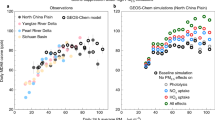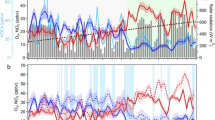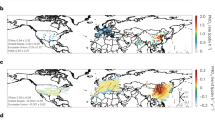Abstract
Tropospheric ozone pollution is a critical air-quality concern in China. However, the most effective mitigation approach remains unclear, with prioritizing the reduction of volatile organic compounds or nitrogen oxides (NOX) currently still under debate. Here we analyse observational measurements of ozone in August, as well as its precursors, from urban Beijing between 2006 and 2020. We show that, despite a continuous increase in the primary atmospheric oxidant (hydroxyl radical, OH), ozone increased until 2014 and then decreased. This ozone trend can be explained by changes in OH turnover rate, primarily determined by the reactivity ratio between volatile organic compounds and NOX. Overall, reactive abatement of volatile organic compounds should be a near-future priority for ozone-pollution control in China, followed by further NOX controls.
This is a preview of subscription content, access via your institution
Access options
Access Nature and 54 other Nature Portfolio journals
Get Nature+, our best-value online-access subscription
$29.99 / 30 days
cancel any time
Subscribe to this journal
Receive 12 print issues and online access
$259.00 per year
only $21.58 per issue
Buy this article
- Purchase on Springer Link
- Instant access to full article PDF
Prices may be subject to local taxes which are calculated during checkout




Similar content being viewed by others
Data availability
The data and code to generate the results in the manuscript are freely available at Open Research Data Repository of the Max Planck Society (https://doi.org/10.17617/3.LEFS4A). Source data are provided with this paper.
Code availability
The box model is available from https://sites.google.com/site/wolfegm/models.
Change history
18 December 2023
A Correction to this paper has been published: https://doi.org/10.1038/s41561-023-01360-7
References
Huang, R. J. et al. High secondary aerosol contribution to particulate pollution during haze events in China. Nature 514, 218–222 (2014).
Lu, X. et al. Severe surface ozone pollution in China: a global perspective. Environ. Sci. Technol. Lett. 5, 487–494 (2018).
World Health Organization (WHO). WHO Global Air Quality Guidelines: Particulate Matter (PM2.5 and PM10), Ozone, Nitrogen Dioxide, Sulfur Dioxide and Carbon Monoxide: Executive Summary (WHO, 2021); https://apps.who.int/iris/bitstream/handle/10665/345334/9789240034433-eng.pdf
Zhang, Q. et al. Drivers of improved PM2.5 air quality in China from 2013 to 2017. Proc. Natl Acad. Sci. USA 116, 24463–24469 (2019).
Wang, S. et al. Natural gas shortages during the ‘coal-to-gas’ transition in China have caused a large redistribution of air pollution in winter 2017. Proc. Natl Acad. Sci. USA 117, 31018–31025 (2020).
Lu, X. et al. Rapid increases in warm-season surface ozone and resulting health impact in China since 2013. Environ. Sci. Technol. Lett. 7, 240–247 (2020).
Fiore, A. M., Jacob, D. J., Logan, J. A. & Yin, J. H. Long‐term trends in ground level ozone over the contiguous United States, 1980–1995. J. Geophys. Res. Atmos. 103, 1471–1480 (1998).
Cooper, O. R. et al. Global distribution and trends of tropospheric ozone: an observation-based review. Elem. Sci. Anth. 2, 29 (2014).
Simon, H., Reff, A., Wells, B., Xing, J. & Frank, N. Ozone trends across the United States over a period of decreasing NOx and VOC emissions. Environ. Sci. Technol. 49, 186–195 (2015).
Fleming, Z. L. et al. Tropospheric Ozone Assessment Report: present-day ozone distribution and trends relevant to human health. Elem. Sci. Anth. 6, 12 (2018).
Wang, W. et al. Exploring the drivers of the increased ozone production in Beijing in summertime during 2005–2016. Atmos. Chem. Phys. 20, 15617–15633 (2020).
Zhang, Q. et al. Variations of ground-level O3 and its precursors in Beijing in summertime between 2005 and 2011. Atmos. Chem. Phys. 14, 6089–6101 (2014).
Liu, Y. & Wang, T. Worsening urban ozone pollution in China from 2013 to 2017 – Part 2: the effects of emission changes and implications for multi-pollutant control. Atmos. Chem. Phys. 20, 6323–6337 (2020).
Cheng, N. et al. Ground ozone variations at an urban and a rural station in Beijing from 2006 to 2017: trend, meteorological influences and formation regimes. J. Clean. Prod. 235, 11–20 (2019).
Ma, Z. Q. et al. Significant increase of surface ozone at a rural site, north of eastern China. Atmos. Chem. Phys. 16, 3969–3977 (2016).
Monks, P. S. et al. Tropospheric ozone and its precursors from the urban to the global scale from air quality to short-lived climate forcer. Atmos. Chem. Phys. 15, 8889–8973 (2015).
UN Environment Programme. A Review of 20 Years’ Air Pollution Control in Beijing. Publication (United Nations Environment Programme, 2019); https://wedocs.unep.org/bitstream/handle/20.500.11822/27645/airPolCh_EN.pdf?sequence=1&isAllowed=y
Yang, Y., Liao, H. & Lou, S. Increase in winter haze over eastern China in recent decades: roles of variations in meteorological parameters and anthropogenic emissions. J. Geophys. Res. Atmos. 121, 13050–13065 (2016).
Li, K. et al. Anthropogenic drivers of 2013–2017 trends in summer surface ozone in China. Proc. Natl Acad. Sci. USA 116, 422–427 (2019).
Chinese State Council. Three-Year Action Plan on Defending the Blue Sky 2018 (Chinese State Council, 2018); http://english.mee.gov.cn/News_service/news_release/201807/t20180713_446624.shtml
Kirchner, F. et al. Total VOC reactivity in the planetary boundary layer: 2. A new indicator for determining the sensitivity of the ozone production to VOC and NOx. J. Geophys. Res. Atmos. 106, 3095–3110 (2001).
Sillman, S., Logan, J. A. & Wofsy, S. C. The sensitivity of ozone to nitrogen oxides and hydrocarbons in regional ozone episodes. J. Geophys. Res. Atmos. 95, 1837–1851 (1990).
Edwards, P. M. et al. High winter ozone pollution from carbonyl photolysis in an oil and gas basin. Nature 514, 351–354 (2014).
Sheehy, P. M., Volkamer, R., Molina, L. T. & Molina, M. J. Oxidative capacity of the Mexico City atmosphere – Part 2: a ROx radical cycling perspective. Atmos. Chem. Phys. 10, 6993–7008 (2010).
Jenkin, M., Saunders, S., Wagner, V. & Pilling, M. Protocol for the development of the Master Chemical Mechanism, MCM v3 (Part B): tropospheric degradation of aromatic volatile organic compounds. Atmos. Chem. Phys. 3, 181–193 (2003).
Womack, C. C. et al. An odd oxygen framework for wintertime ammonium nitrate aerosol pollution in urban areas: NOx and VOC control as mitigation strategies. Geophys. Res. Lett. 46, 4971–4979 (2019).
Liu, Y. J. et al. Isoprene photo-oxidation products quantify the effect of pollution on hydroxyl radicals over Amazonia. Sci. Adv. 4, 8 (2018).
Barket, D. J. et al. A study of the NOx dependence of isoprene oxidation. J. Geophys. Res. Atmos. 109, 12 (2004).
Wang, W. et al. The impact of aerosols on photolysis frequencies and ozone production in Beijing during the 4-year period 2012–2015. Atmos. Chem. Phys. 19, 9413–9429 (2019).
Jacob, D. J. Heterogeneous chemistry and tropospheric ozone. Atmos. Environ. 34, 2131–2159 (2000).
Kleinman, L. I. et al. Dependence of ozone production on NO and hydrocarbons in the troposphere. Geophys. Res. Lett. 24, 2299–2302 (1997).
Tonnesen, G. S. & Dennis, R. L. Analysis of radical propagation efficiency to assess ozone sensitivity to hydrocarbons and NOx: 1. Local indicators of instantaneous odd oxygen production sensitivity. J. Geophys. Res. Atmos. 105, 9213–9225 (2000).
Volkamer, R., Sheehy, P., Molina, L. T. & Molina, M. J. Oxidative capacity of the Mexico City atmosphere – Part 1: A radical source perspective. Atmos. Chem. Phys. 10, 6969–6991 (2010).
Mao, J. et al. Atmospheric oxidation capacity in the summer of Houston 2006: comparison with summer measurements in other metropolitan studies. Atmos. Environ. 44, 4107–4115 (2010).
Wang, W., van der A, R., Ding, J., van Weele, M. & Cheng, T. Spatial and temporal changes of the ozone sensitivity in China based on satellite and ground-based observations. Atmos. Chem. Phys. 21, 7253–7269 (2021).
Kang, M., Zhang, J., Zhang, H. & Ying, Q. On the relevancy of observed ozone increase during COVID-19 lockdown to summertime ozone and PM2.5 control policies in China. Environ. Sci. Technol. Lett. 8, 289–294 (2021).
Otero, N. et al. A multi-model comparison of meteorological drivers of surface ozone over Europe. Atmos. Chem. Phys. 18, 12269–12288 (2018).
Tai, A. P. K., Mickley, L. J. & Jacob, D. J. Correlations between fine particulate matter (PM2.5) and meteorological variables in the United States: implications for the sensitivity of PM2.5 to climate change. Atmos. Environ. 44, 3976–3984 (2010).
Wolfe, G. M., Marvin, M. R., Roberts, S. J., Travis, K. R. & Liao, J. The framework for 0-D atmospheric modeling (F0AM) v3. 1. Geosci. Model. Dev. 9, 3309–3319 (2016).
Zhang, L., Brook, J. R. & Vet, R. A revised parameterization for gaseous dry deposition in air-quality models. Atmos. Chem. Phys. 3, 2067–2082 (2003).
Yang, S. et al. The formation and mitigation of nitrate pollution: comparison between urban and suburban environments. Atmos. Chem. Phys. 22, 4539–4556 (2022).
Xu, X. et al. Long-term changes of regional ozone in China: implications for human health and ecosystem impacts. Elem. Sci. Anth. 8, 13 (2020).
Tan, Z. et al. No evidence for a significant impact of heterogeneous chemistry on radical concentrations in the North China Plain in Summer 2014. Environ. Sci. Technol. 54, 5973–5979 (2020).
Wang, H. et al. Model simulation of NO3, N2O5 and ClNO2 at a rural site in Beijing during CAREBeijing-2006. Atmos. Res. 196, 97–107 (2017).
Hendrick, F. et al. Four years of ground-based MAX-DOAS observations of HONO and NO2 in the Beijing area. Atmos. Chem. Phys. 14, 765–781 (2014).
Kleinman, L. I. The dependence of tropospheric ozone production rate on ozone precursors. Atmos. Environ. 39, 575–586 (2005).
Acknowledgements
X.L. received financial support from the Beijing Municipal Natural Science Fund for Distinguished Young Scholars (JQ21030) and from the National Natural Science Foundation of China (91644108, 91844301). F.R. and A.W. received financial support from the Federal Ministry of Education and Research, Germany (01LP1929A, Practice). Hang Su was supported by the National Key Scientific and Technological Infrastructure project “Earth System Science Numerical Simulator Facility” (EarthLab).
Author information
Authors and Affiliations
Contributions
H.S., Y.L., Y.Z. and Y.C. conceived and designed this study, and revised the Article critically. W.W. and X.L. acquired, analysed and interpreted data, drafted the Article, and revised it critically. R.N. and Y.C. performed the chemical transport model simulations. D.D.P., F.R., A.W., R.N., Z.T. and U.P. revised the Article critically. Q.Z. provided the emission inventory data. Y.L., S.L., Y.W., S.C., K.L., M.H., L.Z., M.S., C.H., X.T., K.M.L., L.C. and M.F. collected data.
Corresponding authors
Ethics declarations
Competing interests
The authors declare no competing interests.
Peer review
Peer review information
Nature Geoscience thanks the anonymous reviewers for their contribution to the peer review of this work. Primary Handling Editor: Xujia Jiang, in collaboration with the Nature Geoscience team.
Additional information
Publisher’s note Springer Nature remains neutral with regard to jurisdictional claims in published maps and institutional affiliations.
Extended data
Extended Data Fig. 1 Seasonal variation of O3 in Beijing.
The dot represents the mean of MDA8 O3 concentrations for each month during 2014-2020 and the error bar represents the standard deviation, with sample size of 1940 daily values in total (averages of 12 NMN sites in Beijing, for which the measurement data are available since 2014).
Extended Data Fig. 2 Variations in column concentrations of NO2 and formaldehyde (HCHO) in Beijing, August between 2006 and 2020.
Results are from satellite measurements.
Extended Data Fig. 3
Variations in observed VOCR, NOXR, VOCR/NOXR, O3 and normalized O3 in August in Shanghai (A), Yangtze River Delta and Hong Kong (B), Pearl River Delta under clear-sky conditions.
Extended Data Fig. 4 Model-simulated relationship between OH, O3 and precursors - VOC and NOX.
The levels of NOXR and VOCR in 2006, 2014 and 2020 are marked in dashed lines.
Extended Data Fig. 5 Correlation between kHO2+NO[HO2][NO] and [OH]×VOCR simulated by the box model.
VOCR and NOXR ranges from 0 to 16 s-1 and from 0 to 10 s-1 with respective 40 equal-distance steps. Each dot represents a combination of VOCR and NOXR levels. The dots are colored by different ChL levels. The black line corresponds to 1:1 ratio.
Extended Data Fig. 6 Isopleth plots for O3 as a function of NOXR and VOCR in summer, Shanghai.
Red solid circles represent the average levels of MDA8 O3 for each year during 2011-2019, and the solid lines indicate fits to the trend. The yellow dotted lines indicate the VOCR level from biogenic emissions. The blue and magenta arrows indicate future routes for VOCs and NOX abatement that mitigate ozone effectively in the short term (2019-2025) and long term (after 2025), respectively.
Supplementary information
Supplementary Information
Supplementary Text 1–7, Figs. 1–15 and Tables 1 and 2.
Supplementary Data 1
Source data of Supplementary Figures
Source data
Source Data for Figs. 1–4 and Extended Data Fig. 1-6
Fig. 1. Trends of VOCR, NOxR, VOCR/NOXR, O3 and normalized O3. Figure 2. Model-simulated OH concentrations and OH×VOCR. Figure 3. Trends of P(ROX) and ChL, diurnal profiles of modeled rates of primary ROX production, dependence of OVOCR on VOCR/NOXR ratio. Figure 4. Isopleth plots for O3 and total OH turnover rate as a function of NOXR and VOCR. ED Fig. 1. Seasonal variation of O3 in Beijing. ED Fig. 2. Column concentrations of NO2 and formaldehyde (HCHO) in Beijing. ED Fig. 3. Observed VOCR, NOXR, VOCR/NOXR, O3 and normalized O3 in August in Shanghai and Hong Kong. ED Fig. 4. Model-simulated relationship between OH, O3 and precursors - VOC and NOX. ED Fig. 5. Correlation between kHO2+NO[HO2][NO] and [OH]×VOCR simulated by the box model. ED Fig. 6. Isopleth plots for O3 as a function of NOXR and VOCR in summer, Shanghai.
Rights and permissions
Springer Nature or its licensor (e.g. a society or other partner) holds exclusive rights to this article under a publishing agreement with the author(s) or other rightsholder(s); author self-archiving of the accepted manuscript version of this article is solely governed by the terms of such publishing agreement and applicable law.
About this article
Cite this article
Wang, W., Li, X., Cheng, Y. et al. Ozone pollution mitigation strategy informed by long-term trends of atmospheric oxidation capacity. Nat. Geosci. 17, 20–25 (2024). https://doi.org/10.1038/s41561-023-01334-9
Received:
Accepted:
Published:
Issue Date:
DOI: https://doi.org/10.1038/s41561-023-01334-9



